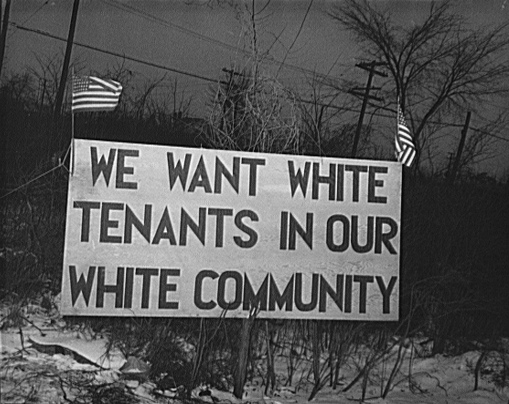Structural Racism and Home Ownership

Look, there’s plenty of reason to pay attention to the horrors of the Trump administration. But let’s say that Donald Trump didn’t exist and the Republican Party was not a fascist force. The condition for millions upon millions of people in this country would be still terrible and we still wouldn’t be taking these problems seriously. And it’s important to continue to discuss these long-term horrors, as we also pay attention to the unique and new horrors that actually do affect middle-class white people, thus getting the attention.
Keeanga-Yamahtta Taylor‘s new book on the banking and real estate industries preying on black consumers is out and you will want to read it. Here’s an excerpt in the Boston Review that gets at these broader issues of long-term oppression and racism that are at least if not more important than Trump.
The quality of life in U.S. society depends on the personal accumulation of wealth, and homeownership is the single largest investment that most families make to accrue this wealth. But when the housing market is fully formed by racial discrimination, there is deep, abiding inequality. There has not been an instance in the last 100 years when the housing market has operated fairly, without racial discrimination. From racial zoning to restricted covenants to LICs to FHA-backed mortgages to the subprime mortgage loan, the U.S. housing industry has sought to exploit and financially benefit from the public perceptions of racial difference. This has meant that even when no discernable discrimination is detected, the fact that Black communities and neighborhoods are perceived as inferior means that African Americans must rely on an inherently devalued “asset” for maintenance of their quality of life. This has created a permanent disadvantage. And when homeownership is promoted as a key to economic freedom and advancement, this economic inequality is reinforced, legitimized, and ultimately accepted.
The regular promotion of homeownership as a means to overcome poverty or as a method of building wealth in our society has been built on a mistaken assumption that all people enter the housing market on an equal basis or that the housing market itself is a neutral arbiter of value. The promotion of homeownership by the state is not only an acceptance of these market dynamics; it is also an abdication of responsibility for the equitable provision of resources that attend to the racial deficit created by the inequality embedded in homeownership. This may seem like a political impossibility in an ongoing atmosphere where public services and institutions are undermined, but it is no more impossible than the magical belief that homeownership will ever be a cornerstone of political, social, and economic freedom for African Americans.
After all, even if there had been no nefarious acts, such as preying upon those desperate for shelter, the racial infrastructure of the housing market still placed African Americans at a disadvantage. These disadvantages continue to play themselves out in the contemporary moment, as Black and white wealth disparities remain entrenched because of their deep roots in a systemically racist and unequal housing market. Even if there is no scandal or controversy, white homes are consistently valued more than Black homes. White neighborhoods are seen as desirable destinations in ways that African American communities are almost never viewed. The historic disinvestment in and physical scarring of Black communities as a result continue to provide the pretexts necessary to finance Black homes differently, including charging higher rates of interest and more fees for lending in those communities. The involvement of public institutions in these private practices that are contingent on racial practices is a recipe for continued inequality, compromised inclusion, and unfair outcomes.
For more than fifty years now, the private sector has been viewed as most capable of ending the persisting urban housing crises. And yet those crises have become even starker over time, creating even greater degrees of housing precariousness. This is especially true in the realm of homeownership. The acceleration of subprime lending in the atmosphere of deregulation in the late 1990s and the early 2000s resulted in unprecedented home losses for African Americans. The practice of subprime lending was contingent on racial practices and assumptions across the housing industry and among the general public. The cascade of foreclosures and mortgage defaults further eroded the value of properties in Black communities, once again, hollowing out the notion of homes as assets for African Americans. The net loss of more than 240,000 homes for African Americans has created the pretext for mortgage lenders to, once again, engage in exclusionary practices that marginalize potential Black homeowners. But this is only one aspect of the crisis. The recurring perception of “risky” Black buyers has opened pathways for the reemergence of naked, predatory practices in the real estate market. From rent-to-own schemes to the reappearance of LICs in lieu of conventional mortgages, real estate continues to pilfer African Americans in search of their American dream in the housing market. It is not history repeating itself. It is the predictable outcome when the home is a commodity and it continues to be promoted as the fulfilment and meaning of citizenship.
I mean, sure, we could have real integrated neighborhoods. But what about my property values? Not to mention the schools little Keegan and Madison are attending. Besides, I can’t be racist, I voted for Hillary! Let’s just hope a Democrat wins in 2020 that I can go back to pretending like the United States is a great country that lets freedom ring!


